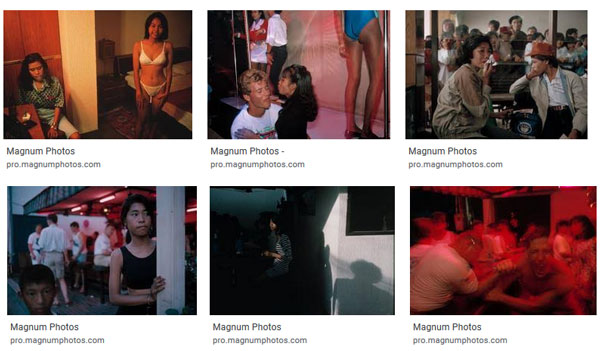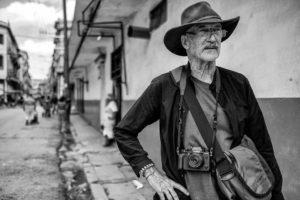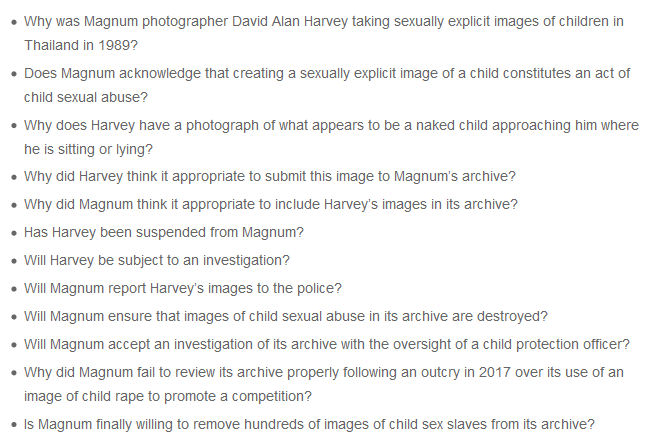Magnum Photos‘ reputation is under threat, according to an Fstoppers writer who uncovered photos from 1989 still available for licence, showing Bangkok child sex workers.

The photo industry is currently riven with serial ‘callings out’ of the old masters of the trade – men who probably thought they were on the side of the angels until quite recently. Activists are unearthing ‘problematic’ statements, actions or images, and demanding answers from individuals and organisations responsible or associated with what they define as offending content.
Inside Imaging recently covered the cancellation of Martin Parr, a Magnum photographer and former president of the venerable agency, who was involved with the re-issue of a photo book from 1969 showing a ‘racist’ photo spread.
In the latest instance Fstoppers senior writer, Andy Day, has written two pieces rallying against Magnum Photos for licensing images from 1989 captured by American photojournalist, David Alan Harvey.
The gritty series, Bangkok Prostitutes, showed life in the seedy underbelly of one of South East Asia’s largest cities, a known destination for sex tourism. The photos show female and male prostitutes on the streets, interacting with western clients at night clubs, along with topless nudity.

As well as being a Magnum photographer since 1997, the previously blameless, 76-year-old Harvey has published a series of books of his work, including Tell It Like It Is, self-published in 1967, documenting the lives of a black family living in Norfolk, Virginia; Cuba and Divided Soul, based on the Spanish cultural migration into the Americas; and Living Proof, dealing with hip-hop culture. He is founder and editor of Burn, a website featuring the work of emerging photographers.
While Magnum Photos has now removed the entire Bankok series, the images were available for licence for 30 years. Day took particular issue with an image showing a topless female. ‘The image is shot from the point of view of the photographer who seems to be on a bed which the girl is approaching,’ writes Day. ‘The girl’s face is not obscured and she is smiling at the photographer’.
While Magnum doesn’t directly caption the female as underage, the Fstoppers writer is deeply concerned by three of the 14 search tags, ‘Prostitute’, ‘Breast’, and ‘Teenage girl – 13 to 18 years’. He suggests the latter tag serves as evidence the teenage woman may be underage.
Day states the pictures ’emerged’ after ‘research’, where he searched for ‘girl’ and ‘prostitute’ in the Magnum Archives. He did similar research at Getty Images, with similar results.
‘The archive of Magnum Photos features numerous photographs of child sex workers, many of whom were photographed without their knowledge. Several of these photographs are sexually explicit, featuring nudity and encounters with clients. These images may constitute acts of child sexual abuse.’ (It’s not known whether Day has any legal qualifications, but he should probably brush up on defamation law!)
Day questions what exactly Harvey was up to in the room with the topless woman, with what could easily be interpreted as an inference of devious or potentially criminal behaviour. ‘It’s not clear what Alan Harvey was doing in the room photographing what appears to be a child wearing only underwear that he identified as a sex worker’.
While in this instance we are dealing with photojournalism rather than fine art photography, the accusations against Magnum bear a resemblance to the 2008 Bill Henson pile-on, when Australia’s leading fine art photographer exhibited prints of a naked 13-year-old girl. Critics – including the Prime Minister at the time, Kevin Rudd – claimed it was child pornography and sexual exploitation of a minor, while defenders argued the photos were not sexual and removing them was censorship.
Along with prompting Magnum to remove the photos, Day squeezed a statement out of the agency’s PR agency: ‘Like many in the photographic industry, we are re-examining our past archives as we are aware there is material that may be inappropriate. Magnum has accumulated almost one million images over its 73-year history, and we are committed to making this a comprehensive process.’
Magnum has lately been re-aligning the agency to appear more progressive. Along with signing the controversial Photo Bill of Rights (for ‘lens-based workers’), Magnum has thrown support behind the Black Lives Matter movement, appointed a female president, and addressed a perceived lack of diversity by appointing new members with culturally diverse backgrounds.
In his second article Day demands Magnum answer his 12 questions. ‘Magnum Photos needs to provide a response as a matter of urgency. Until it demonstrates an adequate response and offers answers to some crucial questions, its function as a photographic agency should be regarded as untenable’.

Wired Italia, a Conde Nast publication, published an article critical of Day’s campaign. Here’s an excerpt, translated from Italian:
This apparently banal affair, destined to be forgotten within a few days, is the last in order of time to replicate the same script: individual ethical conditions on what is illegal or not, unilaterally promoted as a legal norm with general value, applied by the court of the people of the network – or by individual autonomous judges – who without any quality or reason invoke a summary justice based not on the law but on what they deem right : it is the principle of cancel culture.
The article concludes the internet, once a ‘dream of freedom’, has become the most powerful censorship tool in the hands of an ‘undifferentiated mass of subjects whose sole title often is to have a profile on a social network’.
While Day and his Twitter followers are convinced of the righteousness of their cause, the rest of the photographic community – or at least the sub-set which gets down and dirty in the FStoppers and Petapixel Comments sections – is not as certain of the validity of Andy Day’s campaign: 
![]()





I have not seen this work but this would appear to be an outrageous example of ‘cancel culture’ gone mad. David Alan Harvey is a highly accomplished and recognised photojournalist who was documenting a cultural and social environment situation as he found it over thiry years ago. He is to be applauded for outing some of the appalling exploitation that existed at the time and indeed, may well still exist. Should his work be air-brushed out of history? Absolutely not. The availability of such material for authoritative purposes in supporting campaigns to smash child exploitation must remain. Those who ignore the evils in history are destined to relive them.
Who is this Andy Day of Fstoppers… some sort of latter-day moral policeman? Let’s know what are his achievements to the betterment of society rather than as a shooter of messengers.